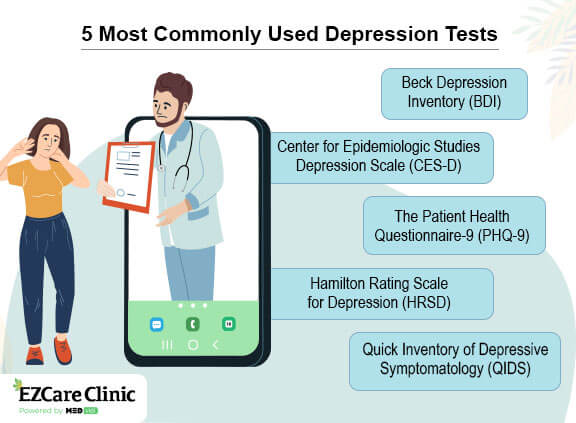Major depressive disorder, which affects more than
Assessing depression symptoms at the beginning of treatment can help determine which therapies are most appropriate. Then, periodic assessments can guide treatment and provide an overview of progress. Today, you can take a depression test online, and its results can assist you in taking the first step on your journey to therapy.
Get an accurate diagnosis from a mental health expert online.
Signs and Symptoms of Depression
There are several types of depression, but some common symptoms are present in all of them. If you have felt at least a few symptoms almost daily for at least two weeks, you may have depression:
- Moods of melancholy, anxiousness, or emptiness.
- Loss of enthusiasm for interests and activities.
- Hopelessness-related emotions.
- Appetite loss or overeating.
- Variances in weight.
- Agitation and irritability.
- A decline in energy.
- Guilt or a sense of worthlessness.
- Sleeping too much or having trouble falling asleep.
- Unknown pains and aches.
- Having trouble focusing or making decisions.
- Thoughts or attempts of suicide.
However, to get a better understanding of your mental state, it is important to not just notice these symptoms but scale them. This is where various self-evaluation tests come in handy. Typically, these tests are built upon the official diagnostic criteria and do not take much time to complete. Several options are reviewed below.
“Am I Depressed or Just Sad?” Try Screening Tests for Depression
Taking self-evaluation tests is a simple method to understand your risk for depression. Even though the only way to know if you have depression is to see a doctor, such depression quizzes can help examine your symptoms and determine whether you need to seek help. The depression tests for teens and adults are usually similar but have some specifics because the symptoms of depression may differ in people of different ages. The most commonly used tests are the following:
1. Beck Depression Inventory (BDI). It is a 21-question multiple-choice self-report used to assess depressive symptoms and moods in those 13 and older. It is one of the most used psychometric tests for assessing depression severity. It includes questions about physical symptoms, including weariness, weight loss, and lack of interest in sex as well as cognitive symptoms like guilt or thoughts of being punished. Each response on the test is given a score between 0 and 3, and the overall score is then compared to a key to evaluate the severity of the depression.
2. Center for Epidemiologic Studies Depression Scale (CES-D). Using this 20-item questionnaire, patients can assess their thoughts and actions throughout the preceding week from the perspective of depression symptoms. It asks people to rate how frequently they experienced loneliness, restless sleep, and sadness during the last week, while some questions are focused on positive emotions (they are scored differently). Each item has a range of response possibilities scored from 0 to 3, and total scoring ranges from 0 to 60. High scores indicate more severe depressive symptoms.
3. The Patient Health Questionnaire-9 (PHQ-9). It is a 9-item self-administered screening based on major depression diagnostic criteria in DSM-IV. It has been

4. Hamilton Rating Scale for Depression (HRSD), also called Hamilton Depression Scale (HDS or Ham-D). It is usually used as part of a clinical interview and is also suitable for those who have already received a depressive disorder diagnosis. It evaluates the level of depression severity, monitors any changes in severity over time, and determines the effectiveness of treatment. If the overall score is below 7, depression is typically absent or in remission, a score of 8 to 16 indicates mild depression, scores of 17 to 23 represent moderate depression, and scores of 24 or higher indicate severe depression. However, scoring criteria varies with different versions of the scale.
5. EuroQol-5 Dimensions Questionnaire (EQ-5D). EQ-5D is a standardized tool used to measure the quality of life due to health conditions. Answering this questionnaire takes under five minutes. The test is non-disease-specific and evaluates five aspects: mobility, self-care, regular activities, pain or discomfort, and anxiety or depressive symptoms.
EQ-5D was first used as a health-related quality-of-life indicator by the EuroQol Group, a team of European academics. Today, two versions are available: the EQ-5D-Y for children and adolescents (8 to 15 years) and a version for adults (age 16 and above). The EQ-5D is utilized all around the world and is available in a variety of languages.
6. The Clinically Useful Depression Outcome Scale (CUDOS). This self-report questionnaire was created to assess the patient’s level of depression. There are 18 questions on it, and the answers range from 0 (not true) to 4 (always true). The items include a variety of depressed symptoms, such as melancholy, a loss of interest in activities, fatigue, a sense of unworthiness, and suicidal thoughts.
7. Quick Inventory of Depressive Symptomatology (QIDS). QIDS is a quick screening tool and a self-report instrument developed to detect depression and monitor changes in symptom severity. It evaluates every essential criterion of the Diagnostic and Statistical Manual of Mental Disorders (DSM), Fourth Edition, for major depressive disorder. It also evaluates symptoms of melancholia or atypical depression. Based on how you’ve been feeling over the past seven days, there are 16 questions to answer from the Inventory of Depressive Symptomatology (IDS). Instead of being geared toward children or teenagers, these questions are intended for adults. The total QID score ranges from 0 to 27.
8. Montgomery-Asberg Depression Rating Scale (MADRS). MADRS is used to gauge the level of depression in patients who have been given a diagnosis of depression. It is made to be responsive to changes brought on by antidepressant treatment. The MADRS consists of ten questions. The MADRS contains the following 10 items:
- Apparent sadness.
- Reported sadness.
- Inner tension.
- Reduced sleep.
- Concentration difficulties.
- Reduced appetite.
- Lassitude.
- Pessimistic thoughts.
- Inability to feel.
- Suicidal thoughts.
These depression tests investigate the relationship between mood, cognition changes, and the physical symptoms of depression, such as fatigue, disturbed sleep, and sex issues. As you evaluate your symptoms, do your best to be as truthful as possible.
See a doctor to get your symptoms evaluated and receive a diagnosis.
Diagnosis of Depression
The above-mentioned self-assessments for depression can indicate depression symptoms, warrant further evaluation if present, and make you consider seeking medical attention. These evaluations, however, are insufficient for a precise diagnosis. Only licensed professionals in mental health are permitted to diagnose depression.
Psychologists, psychiatrists, and other mental health professionals evaluate a patient’s symptoms and match them to the guidelines in the Diagnostic and Statistical Manual of Mental Health Disorders (DSM). They also check for additional diagnostic criteria, apart from symptoms themselves, such as the number and severity of symptoms, their impact on daily functioning, and more. Finally, the following additional factors can aid in the diagnosis of depression:
- A physical examination. Your physician might do a physical examination and inquire about your health. Depression and underlying physical health issues might sometimes be related.
- Tests in the lab. To check that everything is operating normally and rule out physiological causes of your state, your doctor might perform some blood tests.
- Family history. To understand a patient’s risk of developing depression, mental health professionals gather information about the patient’s family history of depression and other mental health conditions. This includes the age of family members when diagnosed, the severity of symptoms, and treatment received.
- Psychiatric assessment. Your mental health expert will inquire about your ideas, emotions, and behavior patterns to rule out the chance that any other disorder is the source of your symptoms.
A Brief Overview of Depression Types
Online depression tests mostly help evaluate the symptoms of major depressive disorder. However, a person can suffer from distinct types of depression. Knowing these types might help you get the proper care for your symptoms.
1. Major depressive disorder (MDD): one of the most prevalent types of depression. A doctor can make a diagnosis if a person experiences depressive symptoms almost daily for at least two weeks.
2. Persistent depression or dysthymia: a persistent, long type of chronic depression. Although it is not as bad as major depression, you might experience mild, moderate, or severe depression symptoms from time to time.

3. Premenstrual dysphoric disorder (PMDD): in the week or two prior to the start of menstruation, PMDD might result in extreme irritation, despair, or worry.
4. Substance/Medication-induced depressive disorder: depressive, anxious, psychotic, or manic symptoms that develop as a natural result of abusing substances or pharmaceuticals are part of this depression type.
5. Seasonal affective disorder (SAD): makes a person suffer from depressive symptoms during particular seasons. Depressive symptoms typically start in the late fall and worsen in winter.
6. Psychotic depression: characterized by not just standard depression symptoms but also psychotic symptoms like hallucinations, paranoia, and delusions.
7. Peripartum/postpartum depression: while it may not be exactly accurate, peripartum depression and postpartum depression are frequently used interchangeably. Unlike peripartum depression, which can happen during and after pregnancy, postpartum depression exclusively happens after childbirth.
Considering the type of depression, you might require a more thorough evaluation.
In the End
Online depression tests cannot replace a clinical diagnosis based on a comprehensive interview. Still, questionnaires and screening tools can assist a mental health practitioner in making a diagnosis. Additionally, these quizzes can help patients determine the severity of their symptoms. Your doctor can then recommend an efficient course of therapy once they have established an appropriate diagnosis.
Sources
- Major Depression
Source link - Psychometric comparison of PHQ-9 and HADS for measuring depression severity in primary care. (2008)
Source link



